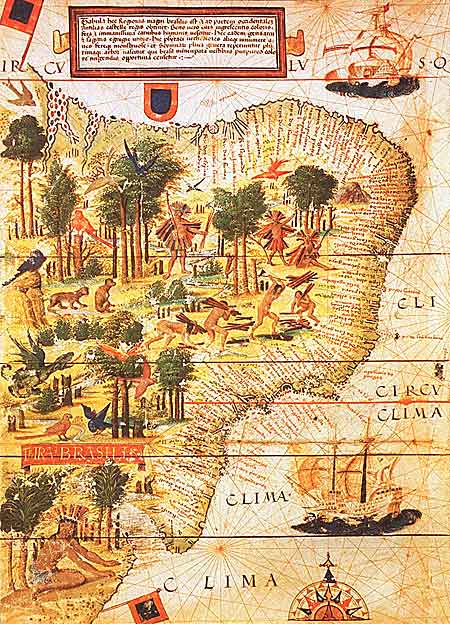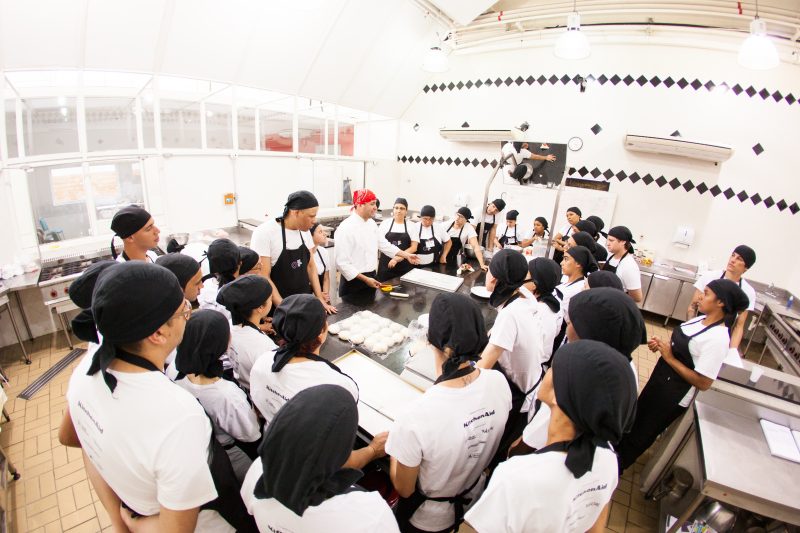Colonization, Globalization and Affinity
Posted on November 30, 2017Since I became a Transdisciplinary Design student, I feel that everyday I have a new unanswered question that most of the times I cannot find the perfect answer. On the past weeks we have been discussing around colonization, globalization, humanitarianism, imperialism, not only on Seminar but those topics are converging from other classes too, what it is more interesting.
Thus, many of those questions that are emerging in my head are related to my own identity. Being a Brazilian, Japanese descendant and now migrating to United States is something that is becoming even more valuable for me as I get older. At the same time I feel that I take more time to identify with some places and become able to can call them “home” (and I feel that it will take time for this), I am also realizing about the qualities this multicultural identity gave me.

Map of Brazil 500 a.C. (Colonialism vision), Folha São Paulo Brasil 500.
Being born in a country totally shaped by colonization, my relation with this subject is very unique. Even though I am not descendant of the Spanish and Portuguese, the first nationalities that colonized Native Indigenous people in Brazil, somehow I am a Japanese descendant from a nationality that also went to that territory and developed many traditions there .With that said, my question is – in what ways we can differentiate colonization of globalization in multiples scenarios? I do feel that we have created new ways of seeing migration, differing migration from the past to current migration, for example.
This is a very personal perspective of the topic, maybe because I feel that my identity is in the middle of these two concepts. But what I would like to frame is that many of the discussion nowadays regarding the design as a form of violence[1] or debating regarding humanitarianism and imperialism[2] I do believe are caused by the idea or misconception of globalization.
As Boehnert and Onafuwa stand for in their article, why sometimes Western designers consider themselves with better solutions than the local communities? And first of all, why designers with humanitarian causes are looking for people in Africa, Southeast Asia?
My answer for this (maybe not the right answer for some) might be that we are heading to a world without boundaries, or we should be going to this place. When we reduce the distances in communication and mentality, we all have access to things we did not have before. You can be on Italy watching news from a hurricane in Haiti.
With many amazing new technologies which reduce the world’s boundaries, why shouldn’t we want to help people in other places? And how to measure the relevance of this issue over another issue in a local community from your own neighborhood?
As I said before, I am now more comfortable with my multicultural identity. And one of the things that I believe I can embrace with, is the concept of affinity. We are always looking for something to relate with, identity with and have affinity with. That is also one of the incredible roles of designers.
So answering the previous question, in a globalized world with multicultural people, you can find your affinity wherever you want. It is not that you care less about your community but maybe you better identify with poverty in Africa, for example. If everyone could find an affinity to work with, we wouldn’t have to measure the relevance from an issue to another, all of them are important and there are enough people to care about each of them.
A good example of this good “colonization” of help for me is Gastromotiva[3], a non-profit institution that I have been involved with since 2014 because I really believe that food and education are two of the greatest issues in the world and we must pay attention on them.

Gastromotiva class in São Paulo, Brazil.
This institution started in Brazil, where they “use the power of food and gastronomy as a social change agent, aiming to transform lives of people living in exclusion and social vulnerability”. They train teenagers so they can work in restaurants and even become chefs. Also, the institution created a space called Refettorio Gastromotiva in Rio de Janeiro where “it works as a food waste restaurant-school with invited guest chefs and young talents from Gastromotiva cooking with surplus ingredients every day. We offer free dinner for vulnerable populations”[3] as they describe in their website.
So considering this issue of food and education is seem in many other countries, they started to expand with the same insights, for example, in Mexico. However, adapting to the country, considering cultural differences and always respecting the needs of those involved into the process. In this case, it is a formula of a incredible cause that worked in a country and it can helps the same issue in another country. How bad is this “colonization” of a project from one country to other?
Now I better understand people that fight for inumerous different causes, it is not because you want to help someone or something that you think another cause is less important, it is just a matter of affinity that we all, as humans, have. Having the sensibility of understanding those differences create more empathy and gather more knowledge to what we aim to change in the world.
We, as designers, can work with globalization to create amazing projects but always with respect of the local community and always considering their priorities and needs. We have the knowledge and the capability of having empathy with people, understanding them and developing for them. When co-creating a solution we have extremely powerful results.
Paula Kawakami
References
[1] J. Boehnert and D. Onafuwa, “Design as Symbolic Violence”
[2] Bruce Nussbaum et al, “Humanitarian Design vs. Design Imperialism: Debate Summary”
[3] Gastromotiva Website. http://www.gastromotiva.org/en/